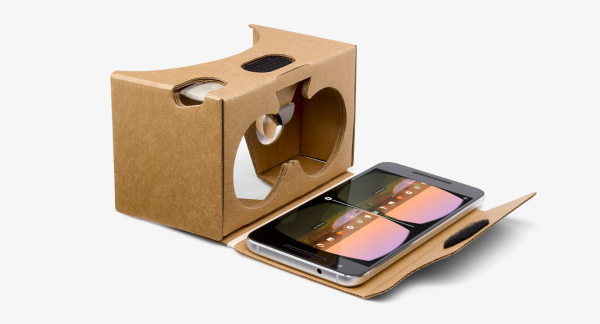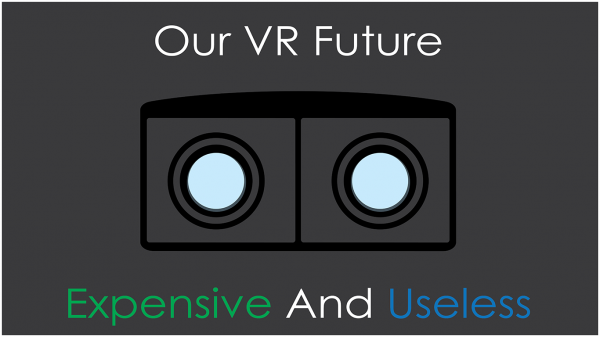Tell Tale Tech: Reality Check
March 4, 2016
Virtual reality (VR) is figuratively everywhere. From a much more literal standpoint however, these constructed graphical environments only exist within the frame of one of a few box-like devices.
A few years ago, major companies in the gaming industry, including Valve and Oculus, released development kits to showcase their then novel technologies. Now, full-fledged consumer release versions of their products are available. Other giants such as Google and The New York Times have since release products in the same vein. However, given the vast difference in use cases and price points, there are a few notable things everyone should know before diving into the virtual world.
There are two tiers of VR devices emerging at this point. The more accessible tier uses your smartphone as the main hardware component to power these simulations. The part that you pay for with these ecosystems are the viewing platforms, which are made of materials from cardboard to metal, and cost anywhere from $20 to over $100. The two major systems you can choose from at this level are Google’s Cardboard or Samsung’s Gear VR, both of which for the most part can be used to watch movies or play a few mobile games in an immersive medium.
Depending on the viewer you purchase, you will either have to strap it around your head or hold it up to your eyes. Both make it impossible to break visual contact (hence the immersion factor) without physically removing the device from your eyes. A smartphone is placed directly in front of the eye holes and secured by the outside of the box. On theses systems, audio comes from the headphone jack as per usual.

Only specific content will be usable, as any graphics, videos, or panoramas have to be specially rendered in a three-dimensionsional format that distributes the image over the two eye pieces. Some companies like the New York Times do have dedicated apps with VR content, but the content is currently sparse. YouTube has also recently rolled out 360-degree videos that enable users to pan around a scene in all directions. And while the cost to the consumer is cheap enough, the technology itself is still relatively useless, unless you wish to spend your free time aimlessly circling around panoramas or watching the occasional documentary.
More capable technologies exist at a higher price point, which do a significantly better job in creating and maintaining the illusion of reality. These devices have higher-resolution displays, utilize wider fields of view and include software enhancements that reduce everything from choppy movements to user-visible rendering.
For comparison’s sake, the HTC Vive, a joint product created by Valve and HTC, is priced at $799. The Oculus Rift carries a similar price tag of $600, well above what most consider a palatable price of entry. At the very top-end, Microsoft’s augmented reality (a supplement to, rather than recreation of) product, HoloLens, just got a price release point of $3,000.
https://www.youtube.com/watch?v=3AADEqLIALk
One must also factor in the cost of the systems (PCs only at this point) that are capable of powering these devices. Both high-end processors and graphics cards are needed to run these devices as intended, since the software and hardware functions are considerably more intensive than everyday computing tasks. For example, even the lowest-end model that Oculus recommends is priced at an additional $800. These minimum hardware requirements are expensive for mainstream consumers and completely impractical. Most laptops simply will not be able to power these devices with any level of success, even if they have a dedicated graphics card.
Even on the off chance that you have thousands of dollars to spend frivolously, there is still not much development going on even with these higher-end systems and thus there won’t be much to do to fill the time.
Sure, Facebook has claimed to have social VR technologies in the works after their acquisition of Oculus back in 2014. But for the most part, the people who buy these more serious technologies will be using them for the purpose of gaming. After all, Oculus, Valve and Sony earn the vast majority of their revenue from this industry already.
And that might be the only cohort of individuals who will actively flock to this technology. For the most part, they all already have the PCs with at least the minimum hardware specs, and a VR headset simply becomes an expensive accessory. And there are some games in development, including an extension of the popular action-based space shooter, EVE: Valkyrie, as well as some more innovative ones such as Crytek’s Climb, which takes advantage of the total immersion factor to create a terrifying representation of rock climbing.
But outside of this select group, VR will have a tough time evolving past a fringe technology. Non-techie consumers will have a hard time adopting this technology given its cost and lack of useful applications. Memorable new technologies, like the iPod, only became mainstream because they were affordable, reasonable to use and had quickly growing content ecosystems.
I don’t believe that VR improves upon actual reality or can justify its absurd cost. For now, hold off on any major VR purchases. If you absolutely have to indulge in this latest tech craze, go for the financial minimum and pick up a $20 Google Cardboard system. Otherwise, reality will just have to do for now.










